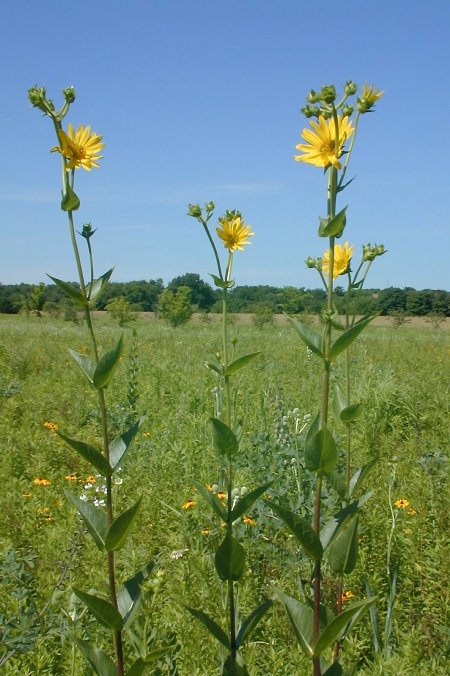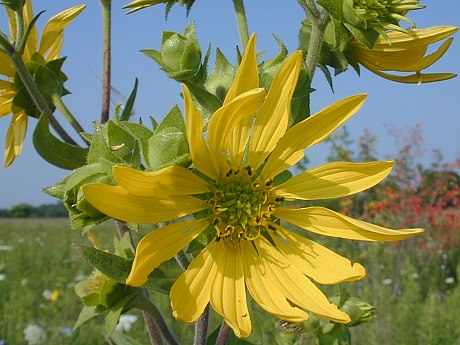Description: This herbaceous perennial plant is 3-5' tall and unbranched, except near the inflorescence. The stout central stem is usually covered with stiff short hairs, but sometimes becomes glabrous with age. It is usually light green, but sometimes turns red in the presence of bright sunlight. The opposite leaves are up to 5" long and 2½" wide. They are broadly lanceolate to ovate, and have stiff small hairs on both the upper and lower sides, providing a sandpapery texture. The margins of these leaves are usually smooth, or they may have tiny teeth. As they ascend the stem, the opposite leaves rotate their direction by 90°. A panicle of composite yellow flowers appear at the top of the plant, resembling small sunflowers.

Each flower is about 2–3" across, consisting of
numerous disk florets surrounded by 12-25 ray florets. Only the ray
florets are fertile. There is no noticeable floral scent. Often, there
are side stems that bear smaller panicles of flowers. The blooming
period occurs from mid-summer to fall, and lasts about 1-2 months. The
seeds are large, flat, and lightweight – they can be carried several
feet by the wind. The root system consists of a taproot and short
rhizomes, which enable this plant to form clumps. Several varieties of
this plant have been reported by various authorities, some of which may
be natural hybrids with other Silphium spp.
Cultivation:
The preference is full sun and mesic to dry conditions. The soil can
contain loam, clay-loam, or some gravel. Rosinweed is rarely bothered
by disease and is easy to grow. It matures more quickly than many other
members of the genus, such as Silphium terebinthinaceum
(Prairie Dock) and Silphium laciniatum (Compass
Plant). Another nice feature of this plant is that it rarely flops over
in the flower garden, if the location isn't on a steep slope.

Range &
Habitat:
The native Rosinweed occurs throughout most of Illinois, except for a
few southern
and western counties (see Distribution
Map). It is a fairly common plant. Habitats include mesic to
dry black soil
prairies, gravel prairies, clay prairies, hill prairies, openings in
rocky upland forests, limestone glades, and areas along railroads,
particularly where prairie remnants occur. This plant can survive
significant degradation, and recovers readily from occasional
wildfires. It competes well against most prairie grasses and forbs in
mesic to dry areas.
Faunal Associations:
The pollen and nectar of the flowers attract long-tongued bees
primarily, including honeybees, bumblebees, Little Carpenter bees,
Epeoline Cuckoo bees, Miner bees, and large Leaf-Cutting bees. Insects
rarely attack this plant, although the Silphium Beetle (Rhynchites
sp.) may feed on the flowers and seeds, and the caterpillars
of the rare Tabenna silphiella (Silphium Moth) eat
the epidermis of the leaves. The larvae of a Gall Wasp (Antistrophus
sp.) may feed within the stems, forming galls that are
invisible from the outside. They attract the hyperparasitic wasp Eurytoma
lutea, whose larvae feed on the larvae of the Gall Wasp. Some
butterflies occasionally visit the flowers, including Sulfurs and
Painted Ladies. Other visitors include short-tongued bees and various
flies. The seeds are eaten occasionally by Goldfinches. Small
herbivores, such as rabbits, are less likely to eat this plant because
of its height and the coarseness of its leaves. However, some large
herbivores, such as cattle, readily consume the foliage, stems, and
flowers.

Photographic
Location:
The photographs were taken at Meadowbrook Park in Urbana, Illinois.
Comments:
Like other Silphium spp., Rosinweed has a fragrant
resin while in flower, which was chewed as gum by Amerindian children.
It is less dramatic in appearance than some of its gigantic cousins,
but matures more quickly and tolerates drought as well or better.
Rosinweed resembles many Helianthus spp.
(Sunflowers), but its disk florets are sterile and ray florets are
fertile. The Sunflowers, on the other hand, have fertile disk florets
and sterile ray florets. Rosinweed tends to produce flowers earlier
than the Sunflowers, but sometimes their blooming periods overlap.
While this plant can form sizable clumps, it doesn't spread as
aggressively by means of underground rhizomes as many Sunflower
species, nor is it known to be allelopathic.